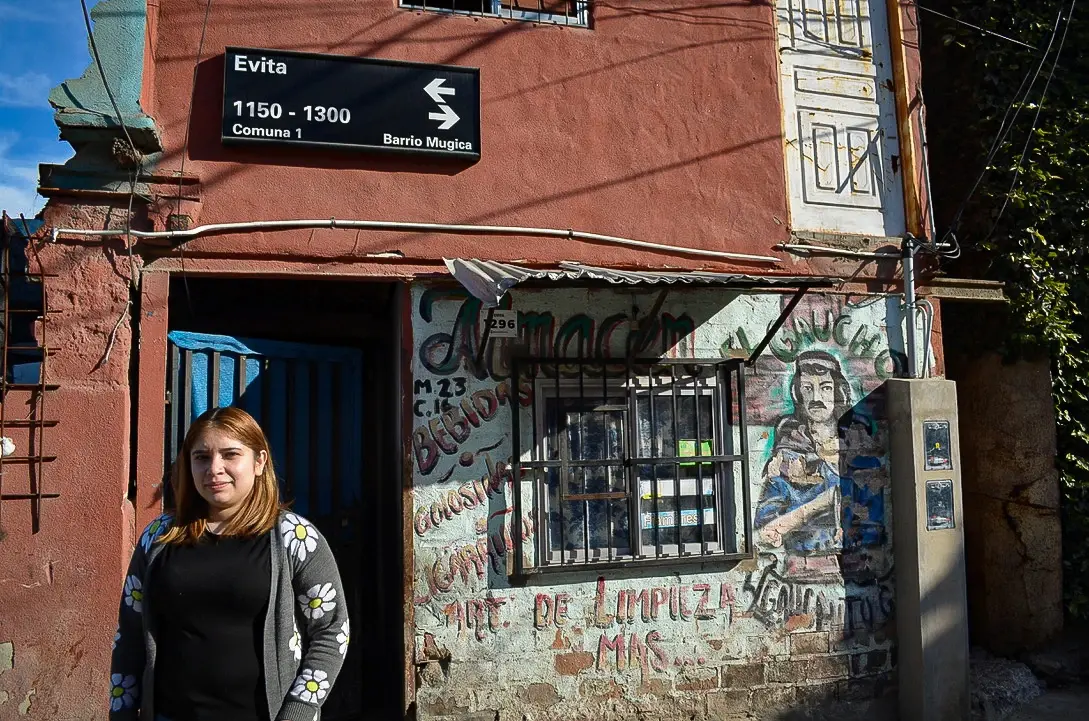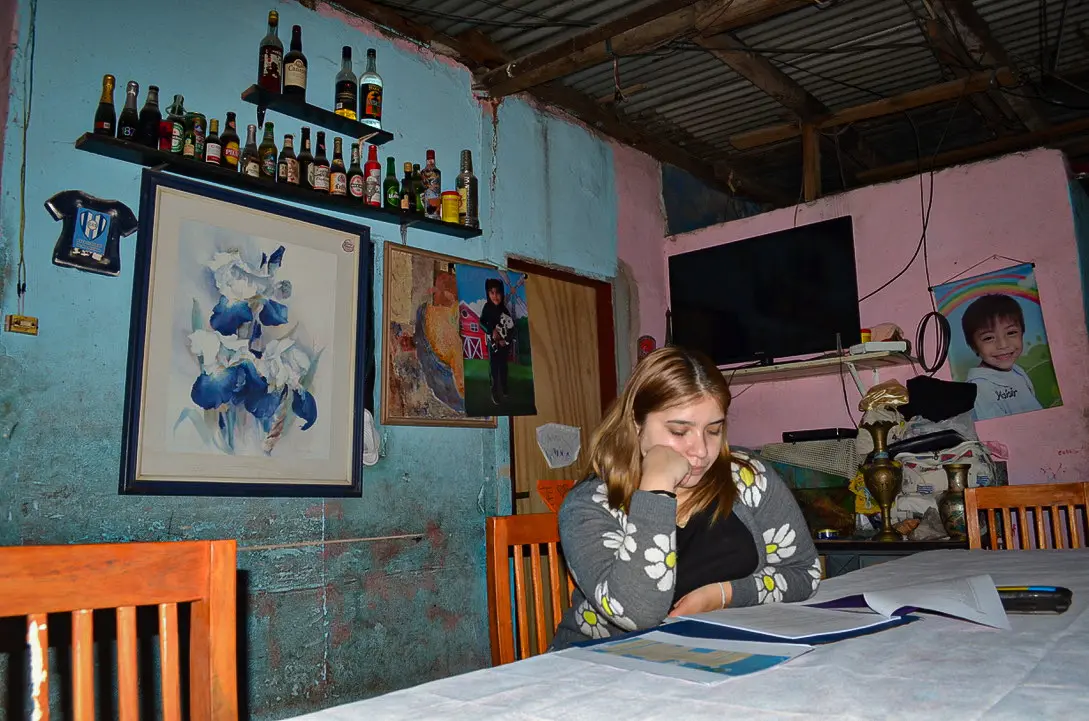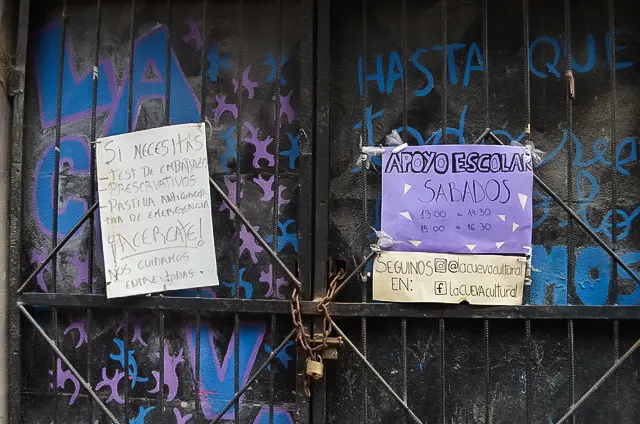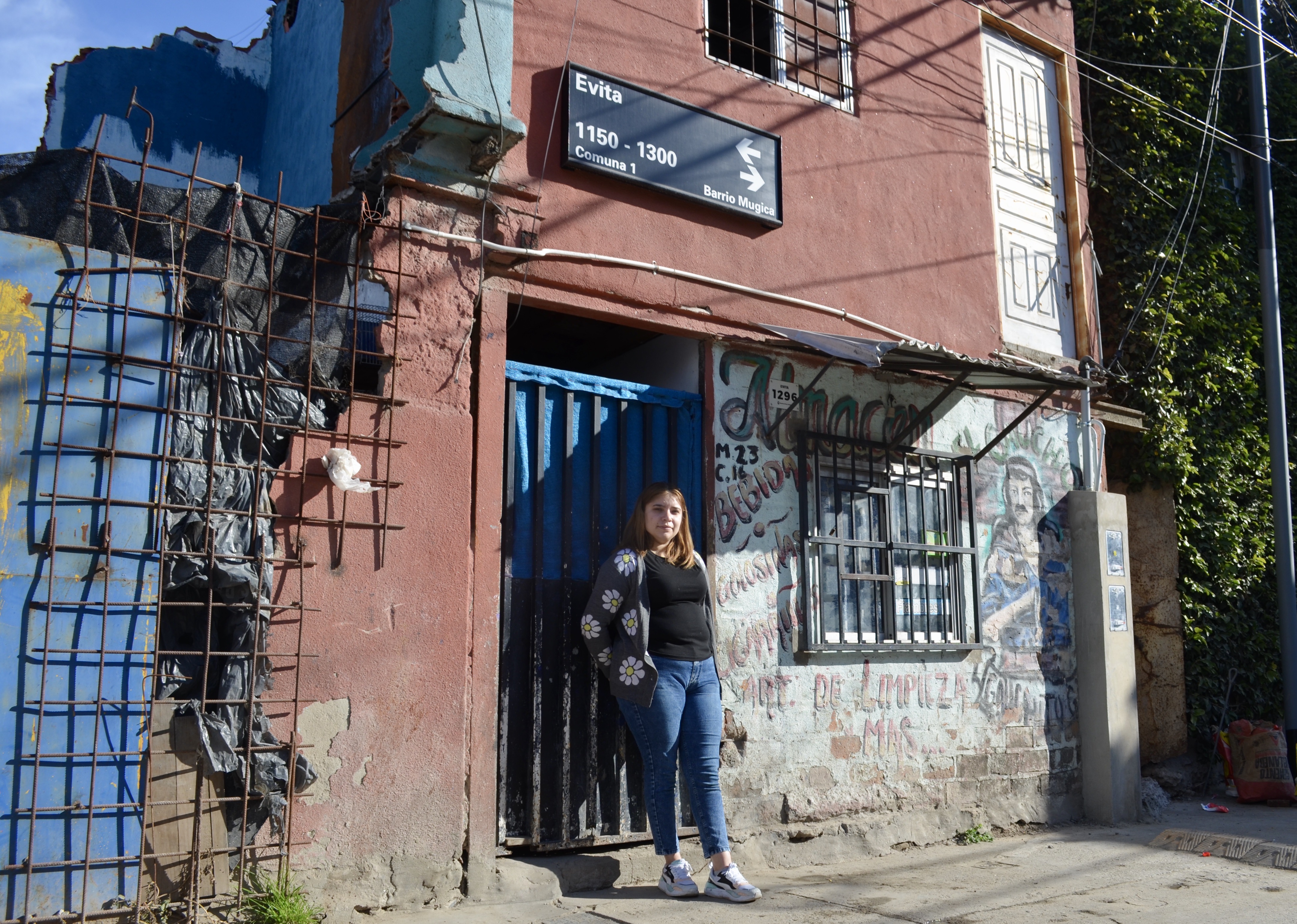In South America, two years of shuttered schools for kids without computers or WiFi ended hopes and dreams for millions. Will they ever get them back?
BUENOS AIRES, ARGENTINA — On a seemingly typical afternoon in 2020 during the first week of classes in her last year of high school, 17-year-old Yasmin Maccio shuffled home after a 30-minute bus ride at the closing of the academic day. Entering her family’s home — which doubles as a kiosco, or local storefront for food and drinks — she set to work finishing her homework and helping four of her younger nieces and nephews to complete theirs.
But for this ambitious student, who dreamed of going to college, learning would effectively end for the foreseeable future. The following day her school closed its doors in the face of a raging Covid-19 outbreak, eventually offering students a chance to connect to a virtual-schooling option. However, like most of their neighbors, Maccio’s household of 11 people didn’t have a computer.
“Pandemic changed the school a lot, to say the least,” Maccio said in Spanish.
Maccio spent her last year of high school without regular classes. Instead, she was reliant on borrowing one of the family’s two cellphones when they were available in order to access her virtual academic instruction.

As a nonprofit journalism organization, we depend on your support to fund more than 170 reporting projects every year on critical global and local issues. Donate any amount today to become a Pulitzer Center Champion and receive exclusive benefits!
In the United States, many parents bemoan the interruptions in their children’s education brought about by Covid as months they will never get back, creating a permanent learning gap. But about 93 percent of students in the U.S. were able to attend virtual classes, and 99 percent were able to return to some semblance of in-person instruction by December 2021.
What was a deeply painful, mentally challenging interlude for students in the United States became a permanent end to learning for many students in Latin America and the Caribbean. The joint Latin America/Caribbean region is considered one of the two most severely impacted regions in the world regarding educational issues, along with sub-Saharan Africa, according to a June 2022 UNICEF report.
“Education wise, this has been a catastrophe,” Mariana Ibanez, a longtime volunteer in Maccio’s neighborhood of Barrio 31, told me in Spanish.
In Argentina’s capital city, perhaps nowhere is the region’s educational crisis more apparent than Barrio 31 — home to some 40,000 porteños, slang for natives of Buenos Aires.
El Barrio Mugica, or Barrio 31, historically known as Villa 31, is one of the most infamous slums in Argentina’s capital city, with no official sewage system, running water or connection to the city’s power grid. Ironically, the neighborhood is bounded by Retiro, one of Buenos Aires’ most affluent areas, famed for its French architecture, slew of cultural landmarks and costly apartments.
Despite the physical proximity to luxuries, life in the barrio, for many of its residents, seems worlds away. There, and in other informal settlements, known as barrios populares, the cramped conditions and lack of sanitation made it a breeding ground for the coronavirus at the time of its initial virulent spread.
Between mid-April 2020 — when the first positive coronavirus case was reported within the neighborhood — and the end of May 2020, more than 1,200 cases had been detected in Barrio 31 alone. By then, the neighborhood was estimated to have accumulated 24 percent of the positive cases in the city at large.
Thus, when schools across the world opted to pursue virtual learning formats to account for the health risks associated with coronavirus, schools in and around Buenos Aires were no exception. Yet the majority of students in Barrio 31, including Maccio, lacked many of the resources necessary to join in.

Accessing The (Largely) Inaccessible
While Barrio 31 is one of the largest and most well-known, it is certainly not the only neighborhood of its kind. Of the 3 million people living in Buenos Aires’ metropolis, it is estimated that between 7 and 10 percent live in slums.
Maccio was born and raised in the barrio and became accustomed to its deprivations. She said that her high school, Escuela de Comercio Número 2 Dr. Antonio Bermejo, did not hold classes in person for almost two years. (Numerous officials from the Ministry of Education did not respond to multiple requests for comment.)
Without a computer during virtual school, the children’s primary means of access to their assignments and communication with teachers was via the family’s two cell phones.
Maccio’s family is anything but an anomaly.
In 2021, The City Ombudsman and the Social Debt Observatory of the Argentine Catholic University carried out a frequently-cited study on the social impact of the pandemic in Buenos Aires. According to the research, 12 percent of the city’s households do not own computers — and more than 43 percent of these residents live in barrios populares such as Barrio 31.
Ibanez, the neighborhood volunteer, said that in the majority of families she works with, it is typical to see a family of five children that may only have access to just one or two cell phones — which she said was “hugely insufficient” throughout the pandemic.
Ibanez works as a cultural manager in vulnerable neighborhoods in and around the city, carrying out educational projects that allow access to new technologies. She has been volunteering for six years in Barrio 31. Trained in audiovisual production, Ibanez instructs courses on photography to residents of the barrio — which is how she met Maccio four years ago.
Though Maccio and her family could access their work on the two phones they shared, Maccio and the other students in her family faced regular difficulties in accessing Wi-Fi.
According to the UCA study, of the 8.6 percent of households in the city that lack access to the internet, 45.9 percent are located in villas.
“A lot of times, the internet in the neighborhood would get jammed because too many people were trying to access it,” Maccio said.
Ibanez’s partner, Pablo Messuti, an illustrator and video game programmer, is now finishing up his studies at the University of Buenos Aires to teach literature. He has been an educational support volunteer for 10 years — in both Villa 21/24, located in Barracas, the southeast region of the city — as well as Villa 31.
Covid safety efforts like school lockdowns became an increasingly politicized issue between the Argentine federal government and the City of Buenos Aires throughout the pandemic, the BA Times reported.
Last spring, the federal government announced an initiative to distribute laptops to children across Argentina, but Messuti said that this was not enough to accommodate the problems that many children living within the barrios populares had with accessing their work.
“It did help a lot, but not to the level that it needed to,” Messuti said, when prompted about the computers. “The computers were not of very good quality, and were not properly maintained, for the most part.”
He noted that the scale of the demand quickly overwhelmed the city’s capacity to provide Wi-Fi or, in some cases, its efforts to donate shared computers to people in needy areas.
Messuti added that prior to the pandemic, the city’s government already had antennas set up to provide residents with Wi-Fi across the city, but that these were unreliable sources of internet connection during the height of the pandemic.
“The few antennas that were there were not given proper maintenance, so internet access was one of the biggest problems with learning throughout the pandemic,” Messuti said.
Because so many families lacked access to a stable internet connection or a computer, Maccio said, the emphasis of schooling in the barrio became completing homework assignments and communicating with teachers through correspondence, rather than engaging directly in digital classroom-esque settings.
This phenomenon created its own slew of problems.
Getting Behind
"The school would hand in these activity books filled with assignments, but lots of kids did not even complete them because the schools were generally not stringent about handing them back and correcting them, and offering support,” Maccio said.
Maccio’s experience is illustrated in several studies conducted within the region throughout the pandemic. Clarin, the largest newspaper in Argentina, reported on a study carried out in March 2021, which surveyed 4,400 barrios populares throughout the country at large. Regarding how families kept in contact with teaching staff, one study found that the popular text messaging app, WhatsApp, was utilized by a whopping 76.8 percent of families surveyed, while only 14.1 percent of families surveyed communicated with teachers through video chat programs like Zoom.
Maccio said that for her family, this meant many kids got behind in school, resulting in serious difficulties with writing and reading comprehension, especially for younger children.
“The little ones could not focus on the Zoom meetings. Their classmates all would want to talk at the same time and get distracted by things going on in their homes,” Maccio said. “It made it hard for their teachers to accomplish anything with them.”

Maccio believes that perhaps the worst part of it all is that schools, overwhelmed with the situation at hand, tended to pass the students, despite lack of learning retention.
Ibanez and Messuti also voiced similar concerns about students they met that were being passed by their schools without learning anything new.
“I had a pupil — who was still in school — that I quickly realized did not know how to read at age 12,” Ibanez said. “She was being moved from one school year to the next, despite that she did not know how to read, and this is not uncommon at all.”
Ibanez added that, given the huge obstacles that teachers at schools in barrios populares faced during the pandemic, the workload could become “so overwhelming” that underperforming students were able to fly under the radar.
In Maccio’s final year of secondary school, she had finished the academic year feeling like she had not really learned anything, especially in math.
She said that she and some of her close friends in the barrio, who felt similarly, were all passed by their schools.
The following year, Maccio initially tried to complete the course that is necessary for students in Argentina hoping to enroll in university. However, she found the course quite difficult to understand — given her difficulties learning throughout the pandemic.
Familial and Community Support
Maccio explained that for her own family, the older children offered support for the younger siblings throughout their years of schooling. She said that her mother works long hours cleaning houses, and thus cannot always assist the children with schoolwork. Maccio’s older sister largely stepped into that responsibility, she tells me.
However, for some families in Barrio 31 and other barrios populares, reliance on family members to help out with a child’s schooling is not realistic.
In March 2021, Clarin reported that the social groups responsible for conducting mass surveys of families living in barrios populares consider the development of school support spaces in the neighborhoods to be “vital,” as 55.4 percent of respondents in one survey indicated that they would require “external help” to complete their schoolwork.
This is where the work of volunteers at Apoyo Escolar (loosely translated to “academic support classes”) like Ibanez and Messuti, came in, attempting to lessen the blow of the major learning gaps that children throughout Buenos Aires’ barrios populares were experiencing.
Ibanez and Messuti explained that they have seen “dozens of variations of that same story,” in which the parent or parents in a household are largely absent due to long hours to make ends meet.
Thus, in many cases, the parents in a household in the barrio might not have the time, technology, or actual academic knowledge necessary to properly assist their children with schoolwork.
Ibanez recalled one story in particular that stuck with her in her work throughout the pandemic, of two young brothers Ibanez and Messuti had met via Apoyo Escolar. The children were largely unable to access their schoolwork without the couple’s help.
“We had the applications installed on our phones that were necessary for the boys to do their schoolwork. Whenever the boys saw us [in the barrio,] they asked us to use our phones so they could do their homework,” Ibanez said. “It was clear that they really didn’t have anyone else to explain or help them [obtain access to their schoolwork assignments.]”

Maccio echoed Ibanez’s sentiments, telling me she knows children in the barrio whose mothers do not know how to read or write, so they rely especially heavily on the assistance provided by the Apoyo Escolar programming.
Melisa Massinelli, who now serves as the Educational Director of Buenos Aires-based NGO Reciduca, worked in the Ministry of Education from February 2015 to April 2022. Since 2017, she worked for the Operational Management of Educational Inclusion.
For many families in barrios populares in and around the city, Massinelli told me that school closures were particularly impactful as the role of the school spans beyond that of a place of learning, also offering external “social support.”
For children experiencing issues at home — like domestic violence — school became a space where they could share their troubles, or where a watchful teacher could identify potential problems and school officials could then intervene, according to Massinelli.
She noted during her time at the Ministry that many families also relied on schools to provide their children with meals, which became handouts during Covid.
“In many neighborhoods, especially during the pandemic, families went to collect the ‘food baskets’ and few handed in the tasks that the teachers had prepared,” Massinelli said in Spanish.
The Risk of Abandoning School Altogether
As educational director of Reciduca, Massinelli helps run workshops for adolescents in their last two years of high school to increase their job opportunities when they finish school. She spoke about how the pandemic brought on a wave of absenteeism, and a significant number of students dropping out of school.
“With many of the adolescents that we have worked with, what we’re seeing is a general apathy towards school, a very high percentage of absenteeism, and the risk of dropping out of school due to a heightened number of absences,” she said
For many families throughout the region, particularly those living in barrios populares, Massinelli explained that the need to generate economic income greatly increased, leading many children to abandon their schooling to work with their families instead.
Maccio said that she personally knows several kids who have abandoned their studies altogether, including some of her cousins.
“They did not understand the materials that the school was sending and just got to a point of cluelessness, then dropped out, and needed to work,” Maccio tells me. “Sometimes, it’s just not economically tempting to finish school, and making money can be seen as more important than finishing school, for economic reasons.”
Besides the immediate monetary benefit of dropping out of school to work, she said many students will choose not to return to school simply because the learning losses they experienced made further education a daunting proposition.
“Since school is back in person, they would have to physically return, and have a lot of catching up to do,” Maccio said. “It would probably take years. It would be much more work for them now.”
Messuti said that while volunteers focus on identifying which subjects students struggle with, academic motivation among the most vulnerable children in the barrios populares proved, at times, to be an overwhelming task, given their domestic struggles.
“Many of the children that we worked with were dealing with circumstances so grave, they could not focus on things like mathematics,” Messuti added. “So, we really just try our best to motivate them.”
Past, Present and Future
As longtime volunteers in Barrio 31 and other similar neighborhoods, Ibanez and Messuti stressed that they were able to witness firsthand how preexisting issues worsened for residents of the barrio.
Even though school is back in person, Maccio, too, thinks that the time lost in the classroom, particularly for families living in barrios populares, has already begun to impact students in the long term.
“I’m finding that older kids — kids 19 and older, really want to study, but the younger kids? Not so much,” Maccio, who is now 20, said. “Younger kids want to study less, maybe because they lost time during the pandemic, and have less of an educational foundation. It’s a lot harder to motivate the younger ones.”
For some, the pandemic’s educational impact has already begun to take effect. Maccio, who once dreamed of college, is now enrolled in terciario, Argentina’s post-secondary schooling and vocational trade school system. She will graduate flight attendant schooling at the end of this year, in December. In addition to her studies, she now teaches photography to others in her community — remembering how meaningful the support she received was for her development as a student, throughout the pandemic and prior. (She notes that her friends living outside of Barrio 31 would likely have to pay for the kind of academic assistance that Apoyo Escolar provides.)
Ibanez, Messuti, Masinelli and others who work in the educational support realm wonder what the long-term effects of the pandemic might be — with some foreseeing scars long into the future of thwarted ambitions and dreams of what might have been.
In-person school is now back in session. But for the millions of children who lost two full years of schooling — and the many that will likely never return — the future remains unwritten.
Pablo Messuti contributed to this report.











